Introduction
This report will identify the present strategy of Benihana, its key elements of the overall strategy, resources and capabilities, types of financing that are being employed, and growth plans for the current year’s operations, existing major programs, and expressed attitudes.
The internal environment of Benihana will focus on a number of key points regarding the products and services, various functional areas, managerial team, overall financial condition, and its position against other competitors in the same industry, including its corporate governance programs, organizational structures, and many other issues. In order to asses the current position of Benihana of Tokyo, this paper will also concentrate on external factors like economic factors, present market condition, political situation, government regulations, technology development, and socio-cultural issues.
Background of the Company
The Benihana had actually originated in 1935 in Tokyo by Yunosuke Aoki the father of Rocky as the pioneer of a chain restaurant in Japan. Rocky, the organizer of Benihana in the USA was actually a former Olympic wrestler and visited the USA as a team member of the University wrestling team. During his visit, he was admitted for studying Restaurant Management in the USA and after completing his graduation he performed odd jobs for three years to earn money to start a restaurant business in the USA.
He has conducted research on the eating habits of Americans and the nature of restaurants for three years and identified a number of dilemmas concerned with the US Restaurant industry, such as scarcity of workforce, food waste control, raising the cost and so on, then Rocky derived to implementing his dream to establishing Japanese Restaurants in the USA.
At the very beginning in 1972, Benihana was established as a steakhouse with a unique distinction from the other restaurants that here Japanese cooks at the presence of the customer prepared the foods and the interior decoration of the restaurant maintained as a realistically in the depth of Japanese country inn in the USA. However, In 1964 Benihana founded a modest outlet of forty seated eatery units in midtown Manhattan as an expansion drive, and subsequently, it has introduced more than fifteen units all over the USA among them nine units were directly operated by the company itself and the rest of the were franchised or joint ventured.
Identify the present strategy
Diversification strategy
The founder of Benihana had prepared a diversification plan and come in a memorandum of understanding with a leading restaurant. The rationale behind this decision was that Banihana wanted to share research outcomes and their outstanding food processing system to produce Japanese food under the title of Benihana. However, Benihana was eager to expand its business by ensuring the best quality of the food items, giving a creative environment to the outlets, charging more, offering additional services, and providing extra facilities for young generations.
In addition, there was no Japanese quick-service operator in the US market, so, Rocky thought to merge its business with any large Chinese company to operate together in this market. It could consider that strategy to gain –
- Increasing market power by horizontal, vertical, or related acquisition;
- Overcoming entry barriers in newer or less- repudiated segment.
- Increasing the speed to market;
- Rising diversification;
- Increasing market research;
- Recovering the company from bad experience;
- Negotiating for a site on Guam;
- Attempt to make the people happy;
- Reshaping own competitive scope and so on.
Future expansion or Growth plan strategy
Sasser mentioned that initially, Benihana selected mainly three zones for future growth and USA, Japan and other foreign countries were its preferred place. However, Rocky tried to find out potential market to start new units, for example, Harrisburg, Pennsylvania, Suburbia, New York, Los Angeles, Portland and some Mexican cities were the prospective area to him. Since Benihana is operating and distributing services all over the US market with 87 restaurants, it should consider the following factors to become a successful player –
- Factors of production;
- Demand conditions of related area;
- Related and supporting industries;
- Building of heart relationships with customers by the products;
- Maintaining community services and strong supply chain with the distributors;
- Innovative and diversified adaptive tendency;
- Strategy, rivalry, and structure of Benihana.
Established company practices and procedures
Sasser stated that Benihana is limited to opening five units each year and opening of each new unit cost was at least $300,000. Furthermore, annual report 2008 of Benihana mentioned that this opening cost is rising day by day, for instance, opening a new restaurant expense was US$1.27 and US$1.535 million accordingly in 2007 and 2008, whereas this cost was US$3.440 million in 2008.
Organizational resources
Organizational resources of Benihana include both tangible and intangible assets
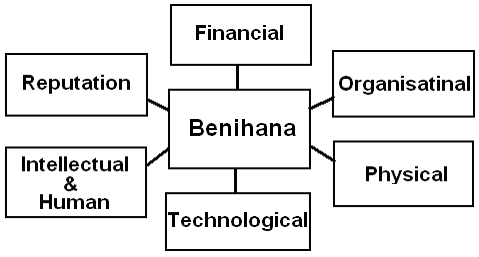
Benihana is capable to gain high profit and sales growth from restaurant business in US market as –
- The organizational structure, operation in high traffic area where many people were going both at lunch and dinner, the size of each store (about 5,000 – 6,000 square feet) are the main resources of Benihana;
- Its physical resources include fixed assets like buildings, store equipments, leasehold improvements, equipments for roasting, and furniture, fixtures and others resulting total value of $257.130 by the fiscal year 2009;
- Behihana’s intellectual human resources are the employees and chefs of the company who are dynamic for technical installation of foods, beverages and other machineries;
- Benihana always affords a high brand value and keeps continuous effort develop in future in US market. So, generated goodwill for the year 2009 was $18.020 million and goodwill for the year 2008 was $29.90 in the overall market of Benihana;
- It develops its machineries regularly to perform its tasks by adopting modern technologies.
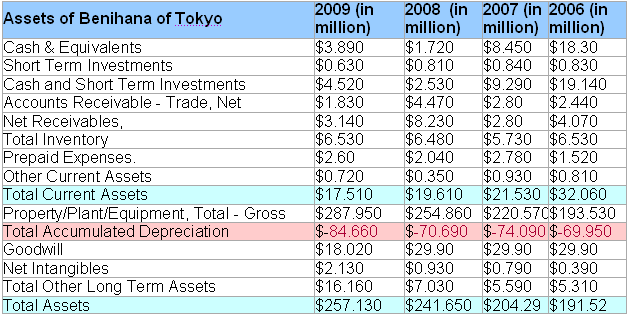
Types of Financing
Initially, individual American entrepreneurs were the main source of investment for franchise though they had little knowledge about the operation system of restaurant. As a result, the franchise success rate was unsatisfactory for the company and Banihana identified that it should require more investment for future success. Sasser pointed out that a leading financial institution has expressed their interest to financing the major requirements of Banihana due to their extreme satisfaction to the high growth rate of the company (6). However, Banihana borrowed US$75 million in 2007 from Wachovia Bank for further development of its four segments with full of confidence. In addition, it had US$17.4 million outstanding credit facilities and to increase the capital, it issued and sold 800,000 shares in 2004.
Present Strategy Considering Basic Functional Areas
The most trouble-free approach to mark out the present strategies of Benihana has drawn by carefully study the given case and then point out the descriptive explanations of its central area of operation, which has identified as below –
- Benihana keeps its effort to strictly mantling the quality of the food,
- It emphasises the presentation of the food artistically,
- The preparation of the food at Benihana deeply concerned with the showmanship of the chefs.
- The taste of the foods of Benihana is the core competence the faced to the customers,
- At Benihana, the authenticity of constriction and authenticity of decoration strappingly maintained with the ethnicity of native country where the flavour of Japanese well fitted through out its communal dinning.
- Benihana has attention to mitigate them its service- constant with youthfulness of staff well built-in with Japanese culture.
- Benihana frequent arranges the presence of celebrities at its outlets to motivate customers.
- It frequently coordinates excitement promotional ideas and conduct campaign such as types of cuisine, moderates price in different occasion and offer discount.
- The overall campaign reflects the uniqueness of the appeal of Benihana with the five senses such as recent growth of popularity of Japanese goods, its quick service at all outlets, extraordinary advertising concept, and exclusive publicity.
- Benihana has banquet and party facilities with no stringent dress requirements for the employees with presence of Rocky Aoki.
- The basic meal of Benihana has low-calorie where customers come through recommendations of friends to avail the chance of meeting friends of the opposite sex as well as Japanese expectorates.
- Benihana uses diverse tool of the restaurant business, it accept most of the credit cards and provides high quality service.
Examine the internal environment of Benihana of Tokyo
Key Strengths of Benihana
- Benihana (2009) stated that Benihana maintains close relationship with its guests, investors and staff and this is the main reason of its success;
- Benihana of Tokyo has long experience of operation as it was established in 1964;
- It has more than 80 outlets in all the state in US;
- Well trained, highly educated and motivated employees are the main strength of this restaurant, for example, it has six to eight highly trained chefs for each outlets;
- It has capability to expand its business outside of Japan and US by selling its franchise and contacting with other companies to work jointly;
- Simple organization structure help to control the company easily;
- From the very beginning, it tried to find out excellent location of the company;
- It should require comparatively low operating cost as it follow cost effective strategies;
Major Weaknesses
- For Benihana of Tokyo, availability of employees and the high cost of labour are the main problem for the operation in US market
- Sasser (5) argued that the owner of this restaurant was bound to stop franchising because investors, who purchased the franchise had no direct experience of restaurant business;
- Communication is another major obstacle for the company as Japanese employees are not habituate to communicate with foreign or US investors;
- Short list of product items decreased the customer interest on the company;
- It has own websites but no online purchasing system, so it can’t offer home delivery services like other multinational companies;
- Lack of loyal customers;
- Its early administration was not to strong for the Benihana of Tokyo;
- However, Japanese chefs were less interested to work in USA but Benihana managed this problem by paying high salary
- Initially, it had to spend at least $300,000 for the Introduction of new units.
The products and services that currently exist
Sasser stated that it has started its business with four items but now it offers huge food items considering the area of its operation (3). However, Benihana of Tokyo is famous for the Japanese cooking system “teppanyaki and Sushi” and it offers seafood items, mouth-watering steak, tender chicken, 15 fresh fish, beef, lobster, stir-fried, broiled steamed, poached, sautéed, char-grilled or deep-fried etc.
The various functional areas
The following figure shows the main functional areas of the Benihana –
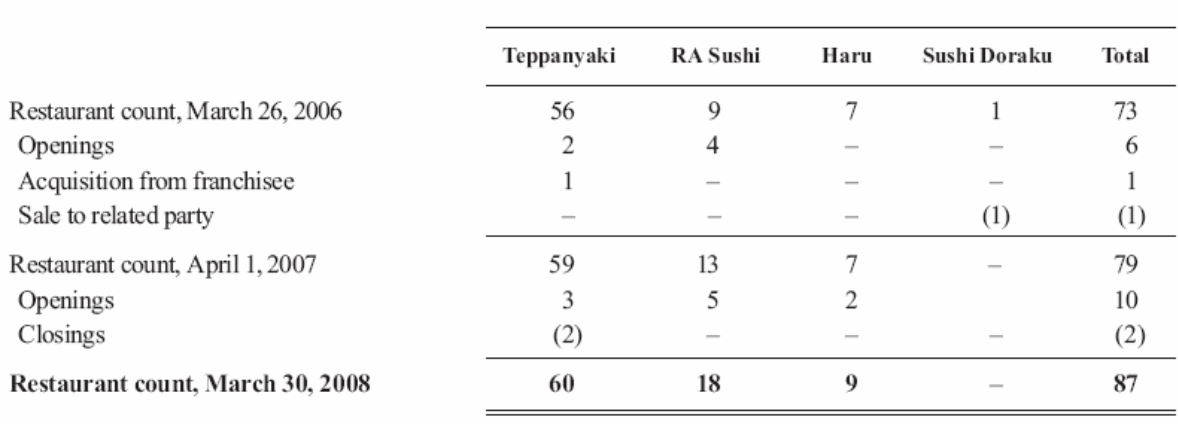
The managerial team
The organizational structure of Benihana of Tokyo is not complicated but combination the work of management team is slightly different other restaurants, as the environment of this company is different from other local restaurants. However, Benihana is highly differentiated in its own industry though the annual report 2008 of Benihana reported that it earns over 95% of total profit from a single business sector that is from food segment and in production process all businesses share materials, technology, marketing process and distribution channels.
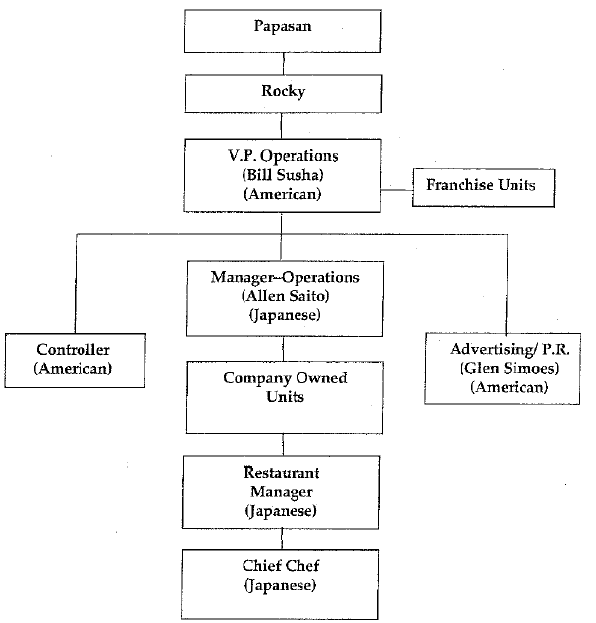
However, it has a highly competent management team for each restaurant, which is responsible to control the performance of the new outlets, training process of the employees, strategic decision-making process, idea generation, and so on. Sasser pointed out the structure of Benihana in early stage and he said that it had a manager, assistant manager and more than 2 potential front men for the training, operation, and business expansion.
The overall financial condition of Benihana of Tokyo
Over bargaining power of suppliers, fluctuations in prices of raw materials, increase rate of electricity, financial down turns, and rent of the outlet are the substantial cause to increase operating expenses of Benihana. As a result, the financial condition of Banihana is in alarming position, for example, in 2009, net loss of the company was $5.07 million while total sales revenues grew by 8.9% and 2.92% in the fiscal year 2008 and 2009. From the above data, it is clear that Benihana should change its existing strategies to reduce operating costs because only increasing sales are not the proper solution for the company to develop the overall financial condition. The following figure represents the above scenario –
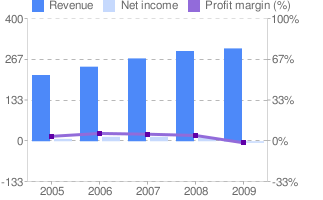
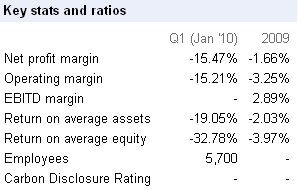
According to the table 1, the number of employees is in same position that indicates it has capacity to control the company without cutting the job of employees, however, the net profit margin, operating and return on average assets of Benihana have decreased from last year.
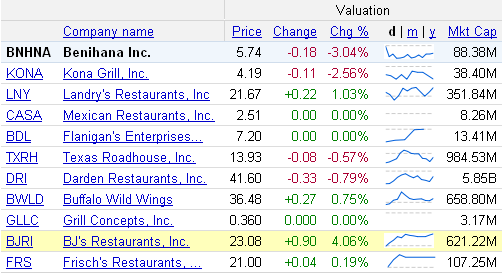
On the other hand, table 2 demonstrates the share price and the change rate of share price of Benihana comparing with similar companies like Kona Grill, Flanigan’s Enterprises and so on. Among the competitors, the share price of BJ’s Restaurants, Frisch’s Restaurants, Landry’s, and Darden Restaurants is in stable position whereas Benihana is in threat of devaluation of share price. However, table 2 shows that Mexican Restaurants, Flanigan’s Enterprises, and Grill Concepts successfully hold their same market position.
How Benihana stand against other competitive in the same industry.
This report will use Porter’s 5 forces model of competition to reveal the actual competitive scenario of Benihana of Tokyo in the US restaurant industry.

- Threats from new entrants: For Benihana, the threats of new entrants are comparatively low for following reasons –
- In this recessionary period, it is difficult to establish business as it should require huge amount of investment;
- Banks and investors are not interested to invest for new fast food industry at this moment;
- It is hard for a new company to build brand awareness;
However, new entrants become a big challenge for the company, if existing branded companies enter in to the US market by using entry mode strategies.
- Bargaining power of the suppliers: The bargaining power of buyer is high for the Benihana, as it has to collect raw materials from various suppliers in order to reduce the production costs and offer high quality food, however the major factors are –
- According to the annual report 2008, Benihana entered into non-cancellable supply contracts for the purchase of particular beef and seafood items to minimize the bargaining power of suppliers;
- However, there are available suppliers for chicken, vegetables, eggs and spices, so these suppliers have little bargaining power;
- On the other hand, supplier’s power is high because this company has to purchase raw materials from different countries for lack of available suppliers of necessary products;
- Bargaining power of the buyers: Buyer has average power on the Benihana though they are key to its success –
- This bargaining power depends on the demand for superior quality, quick services, and other supportive factors like lower price;
- Taste of unique brand item influence the purchaser;
- However, there exists a moderate level of buyer- seller understanding, as customers would not like to expose more bargaining power over price.
- Threats of substitute products: There are numerous substitutes among these companies, the most challenging are home made foods, formal restaurant foods, healthy fast foods etc.
- Benihana upholds the Japanese tradition, so there are no direct substitute in the US market;
- The threat of indirect substitute products are high as there are many Chinese and Indian restaurants, which offer better quality at lower price;
- Rivalry among existing competitors: the annual report 2008 suggested that the restaurant industry is an extremely competitive sector, thus, rivalry relationship exists among most of the restaurants in the US market. For example –
- Nearest Indian, Mexican and Chinese restaurants are the threat for company;
- McDonald’s is the nearest competitor of KFC, Starburk, which are famous for fast food segment and the relation;
- The competition is high, as other similar companies also offer similar facilities and these are Frisch’s Restaurants, Flanigan’s Enterprise, Landry’s Restaurants, BJ’s Restaurants, and Kona Grill.
External environment of Benihana
Opportunities
- Benihana of Tokyo has huge opportunity to expand the business in US market by selling franchise as it has previous experience to work this region;
- As Benihana is aware about its loophole, it will be able to reshape the company by removing hindrance;
- By changing strategies, it can expand its business all over the word like McDonalds, KFC, Pizza Hut etc;
- It has all ingredients to provide home delivery services;
- It has huge opportunity to arrange fund from bank loan to develop its business;
- Besides regular items, the chefs have the capacity to introduce innovative or unique products, which will create new customer base, for example, KFC or Dominos Pizza offer their own branded products;
Threats
- Benihana of Tokyo has huge threat of completion with local and international companies as most of the renowned companies like Starbucks, McDonalds, KFC have operation both in Japan and US market;
- the demand of the food items is decreasing as behaviour of customers has changed due to the global financial down turn, which is another threat for the company and Benihana of Tokyo is waiting for the good time;
- It had failed to meet expectation in stock market and stakeholders lost the confidence;
- Weather conditions;
- Frequent change of rules and regulations;
- Increase litigation costs are another threat for Benihana.
Economic factors
According to the report of Google finance (2010), in 2009, Benihana of Tokyo earned more than $305.6 million from sales but net income was in negative figure (-$5.07) million whereas the net income in 2008 were $12.79. From the last quarter of the fiscal year 2007, its financial condition decreased dramatically, for example, yearly growth rate, net income, and new sales reduced radically. From the economic position of the company, it can assume that its earning is decreasing as the purchasing power of US customer has decreased and customer lost their confidence due to global financial crisis. However, the following figure shows that the earning per share of Benihana of Tokyo is decreasing but its share price was in highest position in 2006 and lowest in 2009.
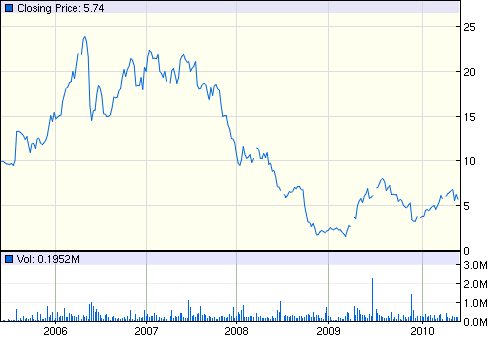
Market condition
Benihana of Tokyo fixes up the price of the products by taking into consideration the market condition, so it is an imperative factor for the company. Initially the market condition of Benihana was not in stable condition for lack of experience but its position has developed day-by-day (Benihana 12). In addition, it has more than 87 stores but it generated net loss $5.07, which is miserable evidence of the market condition (Benihana, 35).
- Market situation and lifecycle: – the following information represents the market condition of Benihana of Tokyo –
Table 4: market condition of Benihana.
- Competitive situation: – The major competitors of Benihana of Tokyo in the food industry are Landry’s Restaurants, Kona Grill, Mexican Restaurants, Frisch’s Restaurants, Flanigan’s Enterprise, and Buffalo Wild Wings etc. However, it has both direct and indirect competitors in the US market, as a result, Benihana offers competitive price for better services and quality foods. According to the report of Google finance, Kona Grill operates in 24 expensive casual dining restaurants, Landry’s Restaurants operates in 174 locations in 27 states and Canada,
- Environmental analysis: – Uncontrollable natural crisis may effects the operation of the business of Benihana, for example – heavy snowfall reduced its sales revenue. However, it has corporate social responsibility to reduce the emission of CO2 so it takes the help of modern machineries for production segments
Political situation
Political factors like investment policies, trade and taxation policies, pressure groups, political trends, interest rate, and shareholders’ demand, derivative agreements, rules and regulations or global financial crisis have the great influence on the operation of its business. According to the annual report 2006 of Benihana, its average bank debt had reduced exceptionally due to decreasing the interest rate.
On the other hand, Benihana has interest on the renovation program but it is not interested to enter into derivative agreements to set up interest rate though it has influence on its net revenue. Here it is important to mention that every of Benihana outlets is the matter to licensing and national law by the health department, sanitation system, security standards, fire extinguisher, and limit to use of alcoholic beverage, and former authorities in the state where the outlets of Benihana is located (Benihana 6);
Government regulation
According to the annual report 2006 of Benihana, it always follows the rules and regulation to avoid the litigation costs and other legal problems. For example, it pursues the provision of Sarbanes-Oxley Act of 2002, new SEC listing rules, recommendations of audit reports, and other related government regulation in order to maintain corporate governance and operate franchise (Benihana 11). As there is a chance of be penalize and restriction of launching new stores, it has to spend large amount of money for professional fees to mitigate legal problems or to success with the growth plans, however, sometimes it has to pay huge compensation according to s.4 of SOA 2002.
Technology development
For Benihana of Tokyo, advance technology plays a vital role to develop innovative products, maintain customer relationship management, advertisement of the product or reduction carbon emission. In addition, technological development and innovation is the major path to become a market leader in US fast food market and it always try to adopt advance new technology to implement and commercialize new products, services, solutions, different design approaches, and so on.
Socio-cultural issues
Benihana of Tokyo has more than 5700 employees who come from different place of the world. In addition, the staff growth rate is about 14%, which demonstrates the strong position of company and provides a clear view the expansion. Sasser pointed out that the socio cultural gap is one of the main causes to stop franchising system in initial stage of expansion, such as it was hard for US investors to communicate with native Japanese employees (2).
However, Benihana of Tokyo removes this cultural problem by arranging three years training and language course for all the chefs as well as for staffs of the company. As a result, the number of outlets of Benihana is increasing not only in US but also in Honolulu, Hawaii etc. though the scenario was different in early stage. However, most of the customers in this region are open-minded and appreciate Japanese food and culture, for which Benihana of Tokyo can earn a huge profit from this zone.
Recommendation
- As Benihana of Tokyo failed to shine the business by franchising, it should increase budget for training though all chefs are highly trained;
- It should remove socio- cultural problems to expand the market outside of the Japan;
- In addition, it should diversify product range considering the trend of international customers, for example, it can introduce new fast food items besides Japanese food as Americans like fast food;
- To develop brand image, it should spend the money to research on advertising policy, as it spends 8% – 10% of total sales for ads and communication with customer but outcomes of these are not enough fruitful for this company;
- Besides Japanese chefs, it can recruit chefs from other countries to reduce operating costs as well as they are aware about their own tradition;
- Moreover, it ought to augment the number of outlets in inside and outside of Japan;
- Due to global financial crisis, the purchasing power of the US and Japanese buyer has decreased dramatically, so, it should decrease the price of the food items to attract more customers;
- In order to offer quality food for the customers, it should not use preservative or chemicals to keep the food fresh;
- Many large companies have collapsed for high salary of the employees as well as executives. In this context, it should reduce the salary of the employees to sustain in recessionary period and it should keep in mind that motivation of employees is also important aspect for the company but reducing salary may hamper their activities. So, it should compare its salary list with the competitors to remove this dilemma;
- It should properly utilize its experience by identifying the problems and removing these obstacles by implementing proper strategies;
- At the time of expansion, it should be more careful to select the appropriate location;
- As it has a well-developed website, it can integrate IT to introduce online purchasing system, so the customer would be able to order and pay by applying online system, which will increase profit of the Benihana of Tokyo.
Conclusion
Benihana of Tokyo is a core Japanese restaurant in US market, which is managing the strategic process in a quite well structured way with adequate amount of resources, capabilities, core competencies, values, social responsibilities, innovative approach, and distribution network. It has already developed the interpersonal skills among the team members to overcome from the cultural problem and expand the business both in inside and outside of the US market.
However, there are some other internal and external factors like – global financial down turn, increasing operation costs and changing the discretions of customers have created huge problems for which in the previous year it has experienced $5.07 net loss. This report provides some recommendation, which will help Benihana of Tokyo to recover its financial position though the company faced a number of major challenges last year.
Works Cited
Benihana. Annual report 2008 of Benihana. 2008. Web.
Google Finance. Basic Chart of Benihana of Tokyo. 2010. Web.
Google Finance. Financial report of Benihana. 2010. Web.
Sasser, Earl. “Benihana of Tokyo.” Harvard Business School. 2004. Web.
